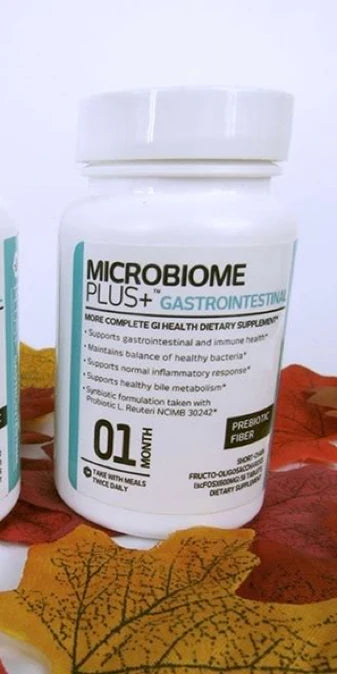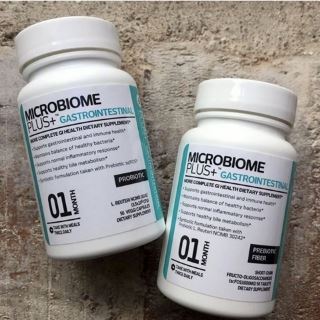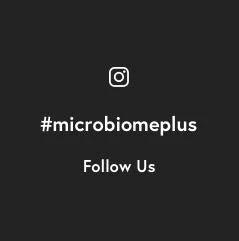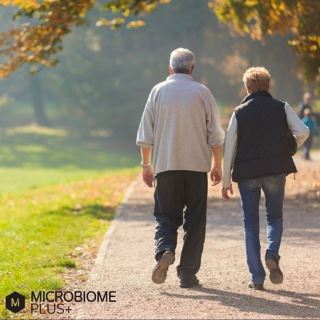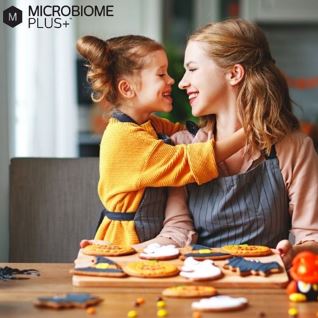Our physiology evolved side by side with the trillions of microorganisms that make up our gut microbiome, serving to protect us against many diseases. The recent shift to the modern lifestyle—toxins, antibiotics, pollutants, and nutrient-depleted food—was a big trigger for gut dysbiosis in populations worldwide. But is there such a thing as the “perfect gut microbiome” and what can you do to stay in balance?
Disclaimer: This post is for informational purposes only. Please discuss your health concerns with your care provider and consult them before taking any supplements to avoid disease and drug interactions.
Your Gut Microbiome at a Glance
What is the gut microbiome & what does it do?
Your gut microbiome—also known as the human intestinal microbiota—is made up of trillions of bacteria and viruses that are considered to be beneficial to health. It plays an essential role in your (Carding et al., 2015):
- Nutrient status, helping to extract, produce and absorb many vitamins, minerals, and other nutrients from food
- Immune health, strengthening immune defense against any foreign invaders, and balancing immune cells to help prevent autoimmune and allergic reactions
- Brain health, helping to boost your mood, energy levels, and cognition while balancing your stress-response axis
- Overall well-being, contributing to a normal anti-inflammatory and antioxidant response that makes you feel good and helps reduce the risk of many chronic diseases
Read about the science of why microbiome supplements do work here.
Maintaining Gut Microbiome Homeostasis
What is gut microbiome homeostasis?
Homeostasis is a state of physiological balance that the body normally strives toward. Recent research reveals that the gut microbiome acts as a central hub for maintaining whole-body homeostasis. It works by encrypting messages into genes and immune cells in the gut lining. These signals are forwarded to other organs, like the brain, and then communicated back to the gut microbiome for final analysis (El Aidy et al., 2013).
Your gut microbiome is not inanimate—it’s a live, moving puzzle that adapts to your lifestyle and surroundings every day. It’s like an energy landscape. Both healthy and dysbiotic states can exist in different places. Moving from one state to another requires external energy (Levy et al., 2017).
If you feed your system healthy factors, an energetic shift toward gut microbiome health (symbiosis) starts to happen. If you add unhealthy factors in, disease-forming tendencies (dysbiosis) start grouping together.

Figure taken from Levy, M., Kolodziejczyk, A., Thaiss, C. et al. Dysbiosis and the immune system. Nat Rev Immunol 17, 219–232 (2017). https://doi.org/10.1038/nri.2017.7
Keeping your gut microbiome balanced is harder than ever before
What are these gut microbiome health boosters, and why is it so difficult to get enough of them?
The reality is that it’s harder than ever before in human history to maintain gut microbiome homeostasis.
Researchers even warn that we’re going through a global pandemic of gut microbiome disruption (Levy et al., 2017).
Inflammatory and metabolic chronic diseases like diabetes, obesity, allergy and asthma, neurodegeneration, and inflammatory bowel disease (IBD) have been massively on the rise over the past two centuries. We’re also seeing more food intolerances and deficiencies in digestive enzymes. Scientists argue that since this has happened over just a couple of generations, it’s unlikely to be due to genetics alone (Levy et al., 2017).
Instead, the likely culprits are changes in our lifestyle and environment. Our way of life today has become so dramatically different in a tiny period of time on an evolutionary scale that we didn’t get a chance to adapt.
Gut microbiome disruptors of the modern lifestyle
Our modern, sedentary lifestyle involves increased exposure to microbiome disruptors like antibiotics, hormones, various drugs, chemical pollutants, processed food, diets low in fiber and nutrients, ultra-hygienic environments, C-sections, and artificial light and heating/cooling systems (Gagliardi et al., 2018; Rinninela et al., 2019).
Researchers further tested this hypothesis by comparing the microbiomes of tribes and rural populations that live traditionally compared to city dwellers.
European children eating a typical Western diet have fewer beneficial gut bacteria and more harmful species (like Shigella and E. Coli) than rural African Burkina Faso children consuming a diet rich in millet and local vegetables (De Filipo et al., 2010).
Compared to the urban Italian population, Hadza hunter-gatherers of Tanzania have higher microbial richness and an overall completely different gut microbiome profile (abundant Proteobacteria and Spirochaetes, no Actinobacteria) (Schnorr et al., 2014).
The Healthy Gut Microbiome
Does the “perfect gut microbiome” exist?
Although we know that certain bacteria are more likely to be beneficial than others, there’s no “one-gut-microbiome-fits-all” solution.
“There is not a unique optimal gut microbiota composition since it is different for each individual,” one group of researchers concluded (Rinninela et al., 2019).
It’s all about finding your gut microbiome health and balance. There is no perfect gut microbiome that we should all aim for.
In general, a healthy gut microbiome is rich in different probiotic bacteria, strong and resilient, and quick to return to balance even after being faced with a threat (Levy et al., 2017).
Each person’s gut microbiome is shaped early in life. Being born vaginally, at term, and getting breastmilk for as long as possible help build a strong gut microbiome that we carry into adulthood. Yet, many miss out on this initial physiological gut microbiome boost due to the rise in C-sections and declining rates of breastfeeding around the world (Rinninela et al., 2019).
Luckily, you can still take diet, weight management, exercise, stress reduction, and lifestyle into your own hands in adulthood to help rebuild or boost the gut microbiome of your infancy (Rinninela et al., 2019).
Understanding the broad range of normal
Scientists are struggling to define what makes healthy vs. unhealthy gut microbiome bacteria. There’s no clear reference point.
The range of “normal” and “healthy” is so broad that it may be completely different from one person to the next depending on geographical location, age, and dietary habits (Levy et al., 2017).
According to analysis, each person shares almost 40% of the gut bacteria with at least half of the general population. This makes up the “core microbiome,” leaving room for huge variations in the remaining 60% (Carding et al., 2015).
It’s impossible to even speak about “good” and “bad” gut bacteria because some species could be beneficial or harmful for one person but not for others (Gagliardi et al., 2018).
Gut microbiome testing companies may create their own healthy reference samples. However, this allows for almost any gut microbiome composition that’s a bit different to be classified as “dysbiotic” (Levy et al., 2017).
Dysbiosis of the Gut
What is it?
In short, gut dysbiosis is a stable state of the gut microbiome that contributes to the development, diagnosis, or treatment of a disease (Levy et al., 2017).
It’s a result of weak internal defense along with some outside threat. As mentioned, dysbiosis is often driven by infection and inflammation, diet and chemicals, and genetics (Levy et al., 2017).
Once these threats overcome the body’s resistance and resilience, the microbiome becomes dysbiotic. Gut microbiome bacteria reduce in diversity and proinflammatory species start dominating. Immune function weakens, triggering more inflammation and increasing the production of toxic and carcinogenic metabolites (Gómez de Cedrón et al., 2020).
It’s important to point out that dysbiosis gradually becomes a stable state, it’s not just a temporary imbalance. That’s also why it can’t be treated with just a couple of days of diet and probiotics, without addressing the underlying issue (Gómez de Cedrón et al., 2020).
Signs and symptoms of gut dysbiosis
The symptoms of dysbiosis are diverse and may include but are not limited to the following (Kamyar et al., Chapter 28 - Dysbiosis, The Theory of Endobiogeny, 2020):
- Gut: indigestion, bloating, bad breath, cramps, inflammation, “leaky gut” (loss of intestinal permeability), constipation, diarrhea, changes in the gut lining, poor nutrient absorption, acid reflux, heartburn
- Immune: food sensitivities, food intolerances, immune reactions to partially digested food (antigen-antibody complexes)
- Skin: acne, skin rashes, psoriasis
- Brain: “brain fog,” trouble focusing, fatigue, poor memory, irritability, mood changes, anxiety
- Other organs: trouble urinating, gallbladder problems, liver burden, joint pain, vaginal or rectal infections or itching, chest pain
- Worsening of inflammatory disorders, including migraines, arthrosis, arthritis, autoimmune disorders, and others
Types of Gut Microbiome Dysbiosis

1) Bloom of harmful bacteria
Bloom of harmful bacteria refers to an increase in so-called “bad bacteria.” These are bacteria that are thought to have the potential to cause disease under certain conditions and include Enterobacteriaceae such as Salmonella, Shigella, and Escherichia coli (Levy et al., 2017; Humphreys et al., 19 - Intestinal Permeability, Textbook of Natural Medicine, 2020)
In some cases, this also involves an increase in putrefying/decay bacteria—mainly a group called Bacteroides—and is called putrefactive dysbiosis. Putrefactive dysbiosis has been linked to eating too much meat and unhealthy fats and not enough fiber (Gagliardi et al., 2018).
2) Loss of beneficial bacteria
This is the most common type of gut dysbiosis, and it involves an overall reduction of known beneficial bacterial species.
These include Lactobacilli and/or Bifidobacteria, especially Lactobacillus reuteri and Bacteroides fragilis. It may also include a reduction in butyrate-producing Firmicutes and others (Levy et al., 2017; Humphreys et al., 19 - Intestinal Permeability, Textbook of Natural Medicine, 2020).
3) Loss of diversity
Gut microbiome dysbiosis almost always involves a reduction in the diversity of gut bacteria—-also called microbial richness (Humphreys et al., 19 - Intestinal Permeability, Textbook of Natural Medicine, 2020).
A perfect analogy of loss of gut microbiome diversity is to imagine land treated with pesticides and chemicals, compared to land for organic farming or permaculture. Few vegetables and fruits can grow on chemically treated and impoverished land, while you can grow almost any combination of plants on healthy and naturally enriched soil. Our gut works in the same way.
4) SIBO
SIBO or small intestinal bacterial overgrowth is a specific type of gut microbiome dysbiosis. The small intestine normally contains very few bacteria. The bacterial overgrowth in SIBO is thought to be due to reduced gastric acid production with an excess of bacterial fermentative activity (Gagliardi et al., 2018).
SIBO is often tricky to diagnose and causes inflammation, gut damage, nutrient deficiency, and various non-specific gut symptoms (Sorathia et al., 2021).
5) Candida
Fungal dysbiosis is when gut microbiome imbalances lead to yeast overgrowth. The most common type is candida overgrowth. The main triggers are a diet rich in sugar and low in fiber, as well as frequent antibiotic use (Gagliardi et al., 2018)
Associated diseases and gut microbiome profiles
Gut dysbiosis has been associated with inflammatory bowel disease (IBD), irritable bowel syndrome (IBS), celiac disease, allergy, asthma, metabolic syndrome, cardiovascular disease, obesity, mood disorders, neurodegenerative disorders, cancer, and others (Carding et al., 2015; Belizário & Faintuch, 2018).
There’s no clear gut microbiome profile for any of the mentioned diseases. However, if you did microbiome testing and are curious to discuss your results and the research with your care provider, or if you’re taking a professional probiotic strain, you may find the findings outlined here relevant.
In experimental studies, the following gut microbiome profiles and diseases have been linked (Gevers et al., 2014; Rinninela et al., 2019; Levy et al., 2017; Nikolova et al., 2021):
- IBD (including Crohn’s disease): increased abundance in Enterobacteriaceae, Pasteurellacaea, Veillonellaceae, and Fusobacteriaceae; decreased abundance in Erysipelotrichales, Bacteroidales, Clostridiales (C. difficile), Escherichia coli, and Fusobacterium nucleatum
- IBS: reduction in Lactobacillus, Actinobacteria, and Bacteroidetes; increase in Proteobacteria and Firmicutes
- Celiac disease: reduction Lactobacillus and Bifidobacterium, increase Bacteroides and E. coli
- Stress: decrease in Bacteroides abundance, increase in Clostridium species
- Rheumatoid arthritis: increase in Prevotella copri and Lactobacillus salivarius
- Type 1 diabetes: general loss of bacterial diversity
- Asthma: germ-free conditions and early-life antibiotic exposure
- Multiple sclerosis: decreased species richness in patients who have active disease
- Colorectal cancer: increase in Bacteroides fragilis, Enterococcus, Escherichia/Shigella, Klebsiella, Streptococcus, and Peptostreptococcus, reduction of Roseburia and other butyrate-producing bacteria of the family Lachnospiraceae
- Obesity: low bacterial diversity, lower relative abundance (50%) of Bacteroidetes, higher Firmicutes
- Alzheimer’s disease: increase in Escherichia/Shigella and Bacteroidetes, reduction in Firmicutes and Bifidobacterium
- Autism: less diversity, lower levels of Bifidobacterium and Firmicutes, higher levels of Lactobacillus, Clostridium, Bacteroidetes, Desulfovibrio, Caloramator, and Sarcina; increase in the Firmicutes-to-Bacteroidetes ratio
- Depression, anxiety, bipolar disorder, psychosis, and schizophrenia: decrease in microbial richness, lower levels of anti-inflammatory Faecalibacterium and Coprococcus, higher levels of pro-inflammatory Eggerthella
- Depression: decreased Firmicutes
- AIDS: low bacterial diversity
- Lupus: decreased Firmicutes-to-Bacteroidetes ratio
More research is needed.
Can probiotics help?
Probiotics of the Lactobacillus and Bifidobacterium species support a healthy gut microbiome. They can be used both to prevent the onset of dysbiosis in people who are exposed to triggers (prolonged antibiotic therapies, intense physical or mental stress, chronic debilitating diseases, etc.) and as part of integrative therapy to rebalance ongoing dysbiosis (Gagliardi et al., 2018).
All Lactobacilli produce lactic acid and are high in many traditionally consumed fermented foods. Lactobacillus probiotics seem to support a healthy immune system and gut and vaginal microbiome (Tannock, 2004; Mu et al., 2018).
L. reuteri (Lactobacillus reuteri) NCIMB 30242 is a unique probiotic strain in Microbiome Plus+ supplements. It has been through rigorous clinical trials published in 7 peer-reviewed scientific papers (Jones et al., 2011, Jones et al., 2012; Jones et al., 2013, Jones et al., 2013; Martoni et al., 2015; Jones et al., 2011; Jones et al, 2012). L. reuteri NCIMB 30242 may help with IBD by nourishing the gut microbiome, balancing levels of intestinal bile acids, and increasing the Firmicutes / Bacteroidetes ratio. It also supports immune function, healthy vitamin D levels, normal total and LDL cholesterol levels, and balanced plant sterol levels.- How to Take Prebiotics and Probiotics Together for Best Results
- What's the Difference Between Probiotics and Prebiotics?
- 100+ Cholesterol Statistics & Heart Health Facts (2022)

Ana Aleksic, MSc (Pharmacy)
Ana is an integrative pharmacist and scientist with many years of medical writing, clinical research, and health advising experience. She loves communicating science and empowering people to achieve their optimal health. Ana has edited 800+ and written 200+ posts, some of which reached over 1 million people. Her specialties are natural remedies, drug-supplement interactions, women’s health, and mental health. She is also a birth doula and a strong advocate of bridging scientific knowledge with holistic medicine.


